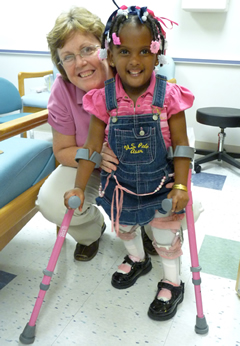Spina Bifida Pictures
Photos and Images
![]()
List of Pictures
Types of Spina Bifida
Myelomeningocele
Protruding Nerves
Meningocele
Spina Bifida Occulta
Spina Bifida Pictures
Types of Spina Bifida
|
|
Spina bifida is a birth defect where the spinal cord fails to develop properly while the baby is still growing in the womb. It is one of the most common types of neural tube defects. The symptoms can range in severity from a dimpling or tuft of hair at the base of the spine, to a minor vertebrae abnormality to complete exposure of part of the spinal cord (known as myelomeningocele).
|
This is the most severe form of spina bifida. It occurs when a portion of the spinal cord protrudes through the back. In some cases the cord sacs are covered with skin, in other instances the nerves are exposed. Generally when doctors refer to spina bifida, they are referring to myelomeningocele. A child born with this defect typically has some paralysis. The extent of paralysis depends on where the opening of the cord is. The higher the opening on the back, the more paralyzed the child tends to be. Those with myelomeningocele nearer the head might be paralyzed and require a wheelchair. |
|
This is where the protective covering around the spinal cord (called meninges) pushes through the baby's back in a sac of fluid called a meningocele. As the spinal cord remains mostly unharmed, this form of spina bifida can usually be repaired without problems. Occasionally it may lead to minor disabilities. |
|
Spina Bifida Occulta: Sacral Dimple This is the mildest form of the condition and children born with this type of defect rarely have any health problems and their spinal cord is largely unaffected (a dimple above the bottom crack may be the only sign). In fact it can often go undiagnosed or may only be diagnosed by X-Ray in adult life as the result of another minor condition such as a back or leg pain. In fact spina bifida occulta is so common that it is estimated that 40 percent of American adults have it. |
 Little Girl With Spina Bifida |
BACK TO HEALTH PICTURES / BACK TO HOMEPAGE |
WOMENS HEALTH ADVICE: ABOUT BIRTH DEFECTS |